
The Merkava is a series of main battle tanks used by the Israel Defense Forces and the backbone of the IDF's armored corps. The tank began development in 1970, and its first generation, the Merkava mark I, entered official service in 1979. Four main variants have been deployed. As of 2023, the Merkava mark IV is the latest version. The Merkava was first used extensively in the 1982 Lebanon War. The name "Merkava" was derived from the IDF's initial development program name.

An autocannon, automatic cannon or machine cannon is a fully automatic gun that is capable of rapid-firing large-caliber armour-piercing, explosive or incendiary shells, as opposed to the smaller-caliber kinetic projectiles (bullets) fired by a machine gun. Autocannons have a longer effective range and greater terminal performance than machine guns, due to the use of larger/heavier munitions, but are usually smaller than tank guns, howitzers, field guns or other artillery. When used on its own, the word "autocannon" typically indicates a non-rotary weapon with a single barrel. When multiple rotating barrels are involved, such a weapon is referred to as a "rotary autocannon" or occasionally "rotary cannon", for short.

The 8.8 cm Flak 18/36/37/41 is a German 88 mm anti-aircraft and anti-tank artillery gun, developed in the 1930s. It was widely used by Germany throughout World War II and is one of the most recognized German weapons of the conflict. Development of the original model led to a wide variety of guns.

The Tank, Infantry, Mk IV (A22) Churchill was a British infantry tank used in the Second World War, best known for its heavy armour, large longitudinal chassis with all-around tracks with multiple bogies, its ability to climb steep slopes, and its use as the basis of many specialist vehicles. It was one of the heaviest Allied tanks of the war.
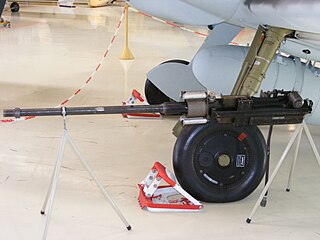
The MG 151 was a German 15 mm aircraft-mounted autocannon produced by Waffenfabrik Mauser during World War II. Its 20mm variant, the 20 mm MG 151/20 cannon, was widely used on German Luftwaffe fighters, night fighters, fighter-bombers, bombers and ground-attack aircraft. Salvaged guns saw post-war use by other nations.

The Bofors 37 mm anti-tank gun was an anti-tank gun designed by Swedish manufacturer Bofors in the early 1930s originally for Swedish use. It was exported to several countries during the 1930s of which several bought licences to produce it themselves. The gun was used in several conflicts but most of its fame comes from its use in the Spanish Civil War and the Winter War where it was used very successfully against light tanks and armored cars among other targets. Beyond its use as an infantry gun it was also used as the main armament in several armored cars and tanks such as the Dutch M39 Pantserwagen and the Polish 7TP to name a few. As the armor of tanks was increased during World War II the gun very quickly became obsolete as an anti-tank gun but was still used effectively as an infantry support gun for the entirety of the war, and well into the Cold War. This was due to its high fire rate, great mobility and effective high explosive shells.

The Sturmgeschütz III assault gun was Germany's most-produced fully tracked armoured fighting vehicle during World War II, and second-most produced German armored combat vehicle of any type after the Sd.Kfz. 251 half-track. It was built on a slightly modified Panzer III chassis, replacing the turret with an armored, fixed superstructure mounting a more powerful gun. Initially intended as a mobile assault gun for direct-fire support for infantry, the StuG III was continually modified, and much like the later Jagdpanzer vehicles, was employed as a tank destroyer.
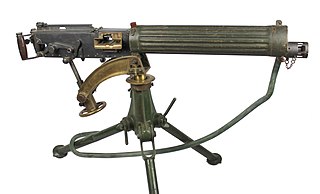
The Vickers machine gun or Vickers gun is a water-cooled .303 British (7.7 mm) machine gun produced by Vickers Limited, originally for the British Army. The gun was operated by a three-man crew but typically required more men to move and operate it: one fired, one fed the ammunition, the others helped to carry the weapon, its ammunition, and spare parts. It was in service from before the First World War until the 1960s, with air-cooled versions of it on many Allied World War I fighter aircraft.

A tank gun is the main armament of a tank. Modern tank guns are high-velocity, large-caliber artilleries capable of firing kinetic energy penetrators, high-explosive anti-tank, and cannon-launched guided projectiles. Anti-aircraft guns can also be mounted to tanks.

The Ordnance Quick-Firing 6-pounder 7 cwt, or just 6-pounder, was a British 57 mm gun, serving during the Second World War as a primary anti-tank gun of both the British and United States Army. It was also used as the main armament for a number of armoured fighting vehicles.
The Type 97 automatic cannon is a 20-millimeter (0.79 in) Japanese anti-tank rifle that began development in the 1930s. It was used by the Imperial Japanese Army (IJA) during the Second Sino-Japanese War, the Soviet–Japanese border conflicts and the Pacific War. Ever-greater thicknesses of armour on tanks rendered the Type 97 obsolete by about 1942. This weapon was not related to the Type 97 heavy tank machine gun used in armored vehicles or the Type 97 aircraft machine gun used in Japanese Navy aircraft.
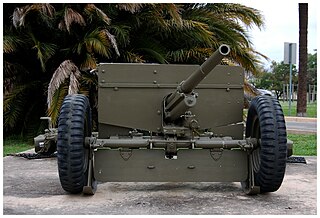
The 37 mm gun M3 is the first dedicated anti-tank gun fielded by United States forces in numbers. Introduced in 1940, it became the standard anti-tank gun of the U.S. infantry with its size enabling it to be pulled by a jeep. However, the continuing improvement of German tanks quickly rendered the 37 mm ineffective and, by 1943, it was being gradually replaced in the European and Mediterranean theaters by the more powerful British-developed 57 mm gun M1. In the Pacific, where the Japanese tank threat was less significant, the M3 remained in service until the end of the war, but some 57mm guns were issued.

The Type 94 37 mm quick-firing gun was an anti-tank gun developed by the Imperial Japanese Army. It was used in combat during the Second Sino-Japanese War and World War II. The Type 94's number was designated for the year the gun was accepted, 2594 in the Japanese imperial year calendar, or 1934 in the Gregorian calendar.

The Shipunov 2A42 is a Soviet/Russian 30 mm autocannon. It is built by the Tulamashzavod Joint Stock Company and named after A. G. Shipunov.
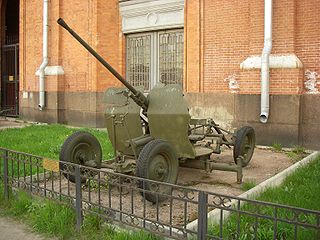
25 mm automatic air defense gun M1940 (72-K) was a Soviet 25 mm caliber anti-aircraft gun used during the Great Patriotic War. The gun was developed from the end of 1939 to the beginning of 1940 at 8th Kalinin Artillery Plant under the guidance of its Chief Designer Mikhail Loginov, supervised by Lev Loktev. The cannon was given the factory code 72-K before being accepted into service by the Red Army as the 25 mm automatic air defense gun M1940.

The QF 1 pounder, universally known as the pom-pom due to the sound of its discharge, was a 37 mm British autocannon, the first of its type in the world. It was used by several countries initially as an infantry gun and later as a light anti-aircraft gun.

The Puteaux SA 18 was a French single-shot, breech-loading cannon, used in World War I through World War II, primarily mounted on combat vehicles. It is closely related to the Canon d'Infanterie de 37 modèle 1916 TRP, also produced by Puteaux.

This article on military tanks deals with the history and development of tanks of the British Army from their first use in the First World War, the interwar period, during the Second World War, the Cold War and modern era.
The post–Cold War era is the period in world history from the collapse of the Soviet Union on December 27, 1991 to the present. During the Cold War, the Soviet domination of the Warsaw Pact led to effective standardization on a few tank designs. In comparison, France, Germany, the United States, and the United Kingdom had previously developed their own tank designs, but now tried to standardize their designs, while the smaller nations of NATO purchased or adapted these designs.
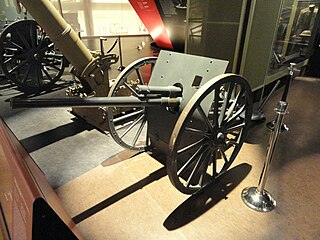
The 37 mm Infantry Gun Model 1917 was a light artillery piece produced in the United States during World War I for the French Army. It was adopted by the US Army when it entered the war on the side of the Allies.





















